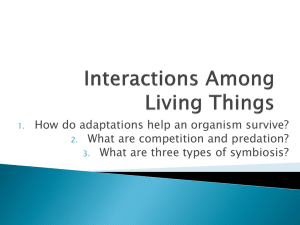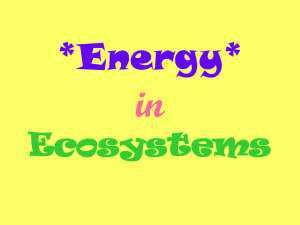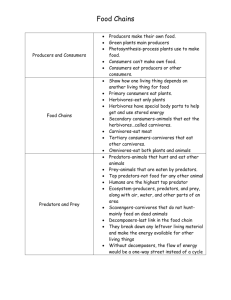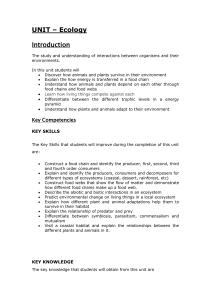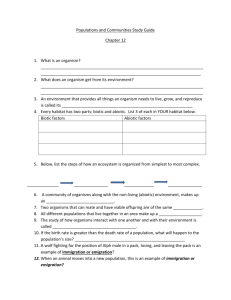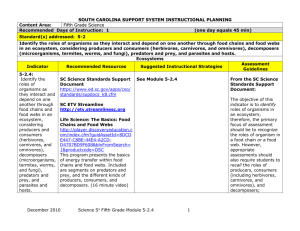Learning Outcomes for Test #19 Name: Unit 5, Lessons 1
advertisement
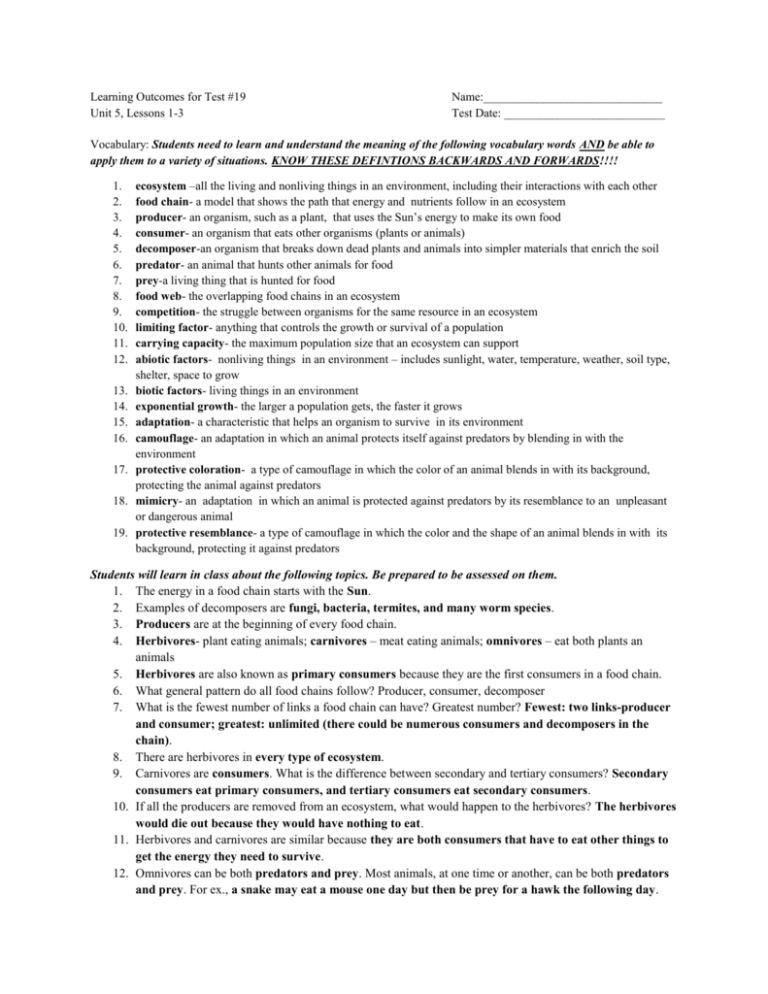
Learning Outcomes for Test #19 Unit 5, Lessons 1-3 Name:______________________________ Test Date: ___________________________ Vocabulary: Students need to learn and understand the meaning of the following vocabulary words AND be able to apply them to a variety of situations. KNOW THESE DEFINTIONS BACKWARDS AND FORWARDS!!!! 1. 2. 3. 4. 5. 6. 7. 8. 9. 10. 11. 12. 13. 14. 15. 16. 17. 18. 19. ecosystem –all the living and nonliving things in an environment, including their interactions with each other food chain- a model that shows the path that energy and nutrients follow in an ecosystem producer- an organism, such as a plant, that uses the Sun’s energy to make its own food consumer- an organism that eats other organisms (plants or animals) decomposer-an organism that breaks down dead plants and animals into simpler materials that enrich the soil predator- an animal that hunts other animals for food prey-a living thing that is hunted for food food web- the overlapping food chains in an ecosystem competition- the struggle between organisms for the same resource in an ecosystem limiting factor- anything that controls the growth or survival of a population carrying capacity- the maximum population size that an ecosystem can support abiotic factors- nonliving things in an environment – includes sunlight, water, temperature, weather, soil type, shelter, space to grow biotic factors- living things in an environment exponential growth- the larger a population gets, the faster it grows adaptation- a characteristic that helps an organism to survive in its environment camouflage- an adaptation in which an animal protects itself against predators by blending in with the environment protective coloration- a type of camouflage in which the color of an animal blends in with its background, protecting the animal against predators mimicry- an adaptation in which an animal is protected against predators by its resemblance to an unpleasant or dangerous animal protective resemblance- a type of camouflage in which the color and the shape of an animal blends in with its background, protecting it against predators Students will learn in class about the following topics. Be prepared to be assessed on them. 1. The energy in a food chain starts with the Sun. 2. Examples of decomposers are fungi, bacteria, termites, and many worm species. 3. Producers are at the beginning of every food chain. 4. Herbivores- plant eating animals; carnivores – meat eating animals; omnivores – eat both plants an animals 5. Herbivores are also known as primary consumers because they are the first consumers in a food chain. 6. What general pattern do all food chains follow? Producer, consumer, decomposer 7. What is the fewest number of links a food chain can have? Greatest number? Fewest: two links-producer and consumer; greatest: unlimited (there could be numerous consumers and decomposers in the chain). 8. There are herbivores in every type of ecosystem. 9. Carnivores are consumers. What is the difference between secondary and tertiary consumers? Secondary consumers eat primary consumers, and tertiary consumers eat secondary consumers. 10. If all the producers are removed from an ecosystem, what would happen to the herbivores? The herbivores would die out because they would have nothing to eat. 11. Herbivores and carnivores are similar because they are both consumers that have to eat other things to get the energy they need to survive. 12. Omnivores can be both predators and prey. Most animals, at one time or another, can be both predators and prey. For ex., a snake may eat a mouse one day but then be prey for a hawk the following day. 13. Predators are an important part of every food chain because they limit the size of prey populations. A population includes all members of a single species in an area at a given time. An increase in size of a prey population is often followed by an increase in the predator population. 14. How is energy from the Sun used by predators? Herbivores eat plants which obtain their energy from the Sun, and then a predator eats the herbivore. 15. Decomposers in a forest break down dead leaves and fallen trees, which recycles nutrients into the soil. There are many types of decomposers. Some break down plants-like earthworms, some break down rotting wood-fungi, and some break down the remains of dead animals. Scavengers are animals that feed on the remains of dead animals that they did not hunt or kill. Common scavengers include jackals, vultures, raccoons, and some crabs. 16. Why does a food chain start again after a decomposer does its job? Decomposers break down dead organisms and, in doing so, return the nutrients stored into these organisms’ bodies into the environment. Plants can use these nutrients, and the cycle starts again. 17. All food chains must have producers, consumers, and decomposers. The Sun provides the energy for almost all food chains. Environments can have more than one food chain because there are a variety of organisms. 18. Food webs are several food chains put together. Arrows represent the energy flow from one organism to another. Food chains are often linked together because organisms can be food for many different animals and animals can eat more than one type of organism. Food webs can allow you to identify which animals are predators, which are prey, and which are both. 19. Be able to identify what organisms would be affected by the removal of an organism in a food websee p. 240 in text. 20. Red tide is a sudden explosive growth of single-celled algae in coastal areas. Red tide can occur when nutrient-rich deep water gets brought to the surface after a storm. With so many nutrients in the water, the algae population quickly grows. Toxins produced by the algae can cause the organisms that eat the algae, including small fish and shellfish, to die. 21. What do you think organisms might compete for in an environment? Food, space, water, sunlight, places to live, mates 22. Together, biotic and abiotic factors determine the carrying capacity for each population. 23. Why is a sudden increase in a predator population usually temporary? An increase in predators will decrease the prey population. With less prey, the predator population will decrease. Eventually, both populations will again increase. 24. When is the carrying capacity for a population within an ecosystem reached? When the number of deaths equal the number of births How do we know that Earth’s carrying capacity for humans has not been reached? The birth rate and the death rate are not equal. The human population continues to grow (meaning we have more births than deaths) 25. Structural adaptations are adjustments to internal or external physical structures. Some structural adaptations help organisms survive in certain environments. Behavioral adaptations are adjustments in an organism’s behavior. Sample behavioral adaptations are traveling in groups, migration, hibernation, etc. 26. Know the difference between migration and hibernation. See p. 251 27. Plants also have adaptations that help them survive in their environments. Plant adaptations help plants get food and water and reproduce in their environments. 28. How do water plants release oxygen and take in carbon dioxide? They have stomata on the top surface of their leaves, unlike land plants, which have them on the bottom. 29. Know about some animal adaptations – see p. 254-255 and also know what the following terms mean: camouflage, protective coloration, and protective resemblance (p.255) 30. How does mimicry help the viceroy butterfly survive? It looks like the bad tasting monarch butterfly, so predators do not eat it.

